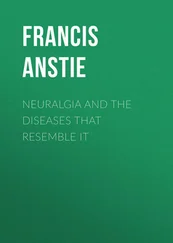Periodontitis and Systemic Diseases
Здесь есть возможность читать онлайн «Periodontitis and Systemic Diseases» — ознакомительный отрывок электронной книги совершенно бесплатно, а после прочтения отрывка купить полную версию. В некоторых случаях можно слушать аудио, скачать через торрент в формате fb2 и присутствует краткое содержание. Жанр: unrecognised, на английском языке. Описание произведения, (предисловие) а так же отзывы посетителей доступны на портале библиотеки ЛибКат.
- Название:Periodontitis and Systemic Diseases
- Автор:
- Жанр:
- Год:неизвестен
- ISBN:нет данных
- Рейтинг книги:5 / 5. Голосов: 1
-
Избранное:Добавить в избранное
- Отзывы:
-
Ваша оценка:
- 100
- 1
- 2
- 3
- 4
- 5
Periodontitis and Systemic Diseases: краткое содержание, описание и аннотация
Предлагаем к чтению аннотацию, описание, краткое содержание или предисловие (зависит от того, что написал сам автор книги «Periodontitis and Systemic Diseases»). Если вы не нашли необходимую информацию о книге — напишите в комментариях, мы постараемся отыскать её.
Periodontitis and Systemic Diseases — читать онлайн ознакомительный отрывок
Ниже представлен текст книги, разбитый по страницам. Система сохранения места последней прочитанной страницы, позволяет с удобством читать онлайн бесплатно книгу «Periodontitis and Systemic Diseases», без необходимости каждый раз заново искать на чём Вы остановились. Поставьте закладку, и сможете в любой момент перейти на страницу, на которой закончили чтение.
Интервал:
Закладка:
Taken together, there is strong and significant evidence that DM has an impact on the prevalence and severity of periodontitis. This evidence has evolved from surveys, case-control studies, narrative reviews and systematic reviews, but mainly from epidemiological studies. The association appears to be similar in T1DM and T2DM; however, the available evidence is focused particularly on T2DM. There is little evidence that the clinical features of periodontitis in patients with DM differ from those without DM. Regarding the impact of periodontitis on DM, there is accumulating evidence that periodontitis contributes to the onset and persistence of hyperglycaemia, poorer glycaemic control in individuals with DM, and an increase in DM incidence 85 , 86.
Interventional studies
Consequently, if periodontitis has a role in diabetes, it would be logical to infer that periodontal therapy impacts circulating levels of inflammatory cytokines, adiponectin, insulin resistance and glycaemic control. Efforts have been made to understand the impact of periodontal therapy in diabetes control. It has been shown that periodontal treatment can improve glycaemic control, lipid profile and insulin resistance, reduce serum inflammatory cytokine levels and increase serum adiponectin levels in T2DM patients 87. Sun et al 87studied 190 moderately to poorly controlled T2DM patients (HbA1c between 7.5% and 9.5%) with periodontitis. They observed that after 3 months of periodontal therapy, the serum levels of C-reactive protein, TNF-α, interleukin (IL)-6, fasting plasma glucose, HbA1c, fasting insulin and the HOMA-IR index decreased, the latter being a method for assessing insulin resistance from fasting blood glucose and insulin concentrations. Adiponectin was significantly increased in the treated group compared to the non-treated group 87.
The positive impact of a non-surgical periodontal therapy on HbA1c was also observed in a recent study by D’Aiuto et al 88. In this 12-month randomised clinical trial, 264 subjects were allocated to receive intensive periodontal treatment (IPT; whole mouth subgingival scaling, surgical periodontal therapy and supportive periodontal therapy every 3 months until completion of the study) or control periodontal treatment (CPT; supragingival scaling and polishing at the same time-points as in the IPT group). They observed that HbA1c was 0.6% (95% CI 0.3% to 0.9%) lower in the IPT group than in the CPT group after 12 months, with adjustment for baseline HbA1c, age, sex, ethnicity, smoking status, duration of diabetes and BMI 88. The question that still remains is whether the observed benefits are sustained beyond 12 months.
The impact of periodontal treatment is largely witnessed by the systematic reviews on this topic. Engebretson and Kocher 89demonstrated in a meta-analysis that periodontal therapy significantly reduced HbA1c 3 to 4 months post-treatment, ranging from 0.27% to 1.03% (95% CI −0.54 to −0.19). In the latest update, Madianos and Koromantzos 90confirmed that non-surgical periodontal therapy reduced HbA1c in patients with diabetes. They observed that there was a reduction 3 to 4 months post-treatment, ranging from −0.27% (95% CI −0.46 to −0.07) to −1.03% (95% CI 0.36 to −1.70) and at 6 months post-treatment, the HbA1c reduction ranged from −0.02 (95% CI −0.20 to −0.16) to −1.18% (95% CI −0.72 to −1.64). The data derived from the meta-analysis clearly indicate the positive effect of periodontal decontamination on glycaemic control. It is important to highlight that this effect cannot be underestimated since, as shown before, for every percentage point decrease in HbA1c, there is a 35% reduction in the risk of microvascular complications, 25% reduction in diabetes-related deaths, a 7% reduction in all-cause mortality, and an 18% reduction in combined fatal and nonfatal myocardial infarction. This further reinforces the hypothesis of a link between periodontitis and diabetes 90.
Conversely, in a multicentre, randomised clinical trial, Engebretson et al 91observed that non-surgical periodontal therapy did not improve glycaemic control in patients with T2DM. However, several authors indicate that the periodontal therapy provided in this study failed to clinically manage the periodontal infection, since the subjects still had high residual plaque levels (72%) and bleeding scores (42%) after the therapy. In addition, the mean HbA1c value at baseline was close to the therapeutic target, thus, a substantial improvement of the HbA1c by periodontal intervention could not be expected. Lastly, the subjects from the treatment group were obese (mean BMI 34.7), which would probably have masked any anti-inflammatory effect of successful periodontal treatment 92.
The controversy regarding the effect of periodontal treatment on glycaemic control may be related to the heterogeneity of the trial designs. These are, for example, non-surgical vs. surgical periodontal therapy provided, the periodontal treatment outcomes assessed, the periodontitis definition used (severity vs. extent vs. both), the selection criteria for the type of DM (T1DM vs. T2DM vs. both), the variability in the range of levels of glycated haemoglobin, and the follow-up periods, where periods of 3 months to assess HbA1c changes may be considered too short 23 , 86. Table 1-4lists the most important interventional studies. It presents the effect of periodontal treatment on glycaemic control of T1DM and T2DM. Table 1-5gives an overview of clinical studies investigating the association between periodontitis and T1DM.
Table 1-4 Interventional studies assessing the effect of periodontal treatment on metabolic control of T1DM and T2DM: treatment group
| Study, country | Groups | Periodontal inclusion criteria | Diabetes inclusion criteria | Therapy | Confounders controlled | Results | Effect |
|---|---|---|---|---|---|---|---|
| Masi et al 93, UK | 51 patients with T2DM and PD;27 IPT; 24 CPT; Mean age: IPT, 56 ± 9 y, and CPT, 58 ± 11 y. | ≥ 15 teeth, ≥ 20 sites with PD ≥ 5 mm and radiographic bone loss. | T2DM according to the WHO criteria and confirmed in specialist. | IPT group received whole mouth SRP at the baseline and 2 mo later. Additional periodontal surgery was performed if there were deeper residual periodontal pockets. CPT patients received supra-gingival scaling and polishing at the baseline and 2 mo later. | Age, gender, race, smoking, BP, cholesterol, cytokines, ROS. | Patients in the IPT group had lower levels of HbA1c 6 mo after therapy compared to CPT patients (average between-group difference of 0.65%, 95% CI 0.22–1.14, P = 0.003). | Yes |
| D’Aiuto et al 88, UK | 264 patients with T2DM and PD; 133 IPT and 131 CPT; Mean age: IPT, 58.2 ± 9.7 y, and CPT, 55.5 ± 10 y. | ≥ 20 periodontal pockets with PD > 4 mm, marginal alveolar bone loss of > 30%, and at least 15 teeth, with active signs of gingival inflammation rather than history of breakdown of periodontal soft and hard tissues. | T2DM (using WHO diagnostic criteria) for 6 mo or longer. | IPT: whole mouth SRP, surgical periodontal therapy, and supportive periodontal therapy every 3 mo until completion of the study. Control: supragingival scaling and polishing at the same time-points as in the IPT group. | Age, gender, ethnicity, smoking, duration of diabetes, BMI. | After 12 mo, HbA1c was 0.6% (95% CI 0.3–0.9; P < 0.0001) lower in the IPT group than in the control group. | Yes |
| Mauri-Obradors et al 94, Spain | 90 patients with T2DM and PD; 48 treatment group and 42 treatment control;Mean age: treatment group, 61 ± 11 y, and control, 62 ± 11 y. | Periodontitis (Armitage 108) at least nine teeth present and > 30% of the probed gingiva with a depth and clinical attachment level ≥ 4 mm. | T2DM diagnosed at least 1.5 years prior the study. | Treatment group: OHI, supragingival scaling and polishing, whole mouth SRP and supportive periodontal therapy when needed until completion of the study. Control: OHI, supragingival scaling and polishing. | Groups matched for: age, sex, medications, duration of diabetes, tooth brushing frequency, interproximal brush use, weight. | After 6 mo, improvement of HbA1c in the treatment group ( P = 0.019) | Yes |
| Engebretson et al 91, USA | 514 patients with T2DM and PD;257 treatment group and 257 treatment control;Mean age: treatment group, 56.7 ± 10.5 y, and control, 57.9 ± 9.6 y. | ≥ 16 natural teeth, CAL and PD > 5 mm in 2 or more quadrants. | T2DM for more than 3 mo; HbA1c 7.0% > 9.0%. | Control: OHI; Treatment group: SRP and chlorhexidine gluconate (twice daily for 2 weeks). | Age, gender, smoking, systemic disease. | After 3 and 6 mo, no statistically significant difference in the HbA1c between the two groups. Control: −0.11 to −0.09; Treatment group: −0.14 to −0.11; P = 0.55; 3 and 6 mo respectively. | No |
| Katagiri et al 95, Japan | 41 patients with T2DM and PD; no controls;Mean age: 63.3 ± 9.9 y. | ≥ 10 remaining teeth, at least two sites with a PD ≥ 4 mm. | HbA1c 6.2% > 10.4%. | All patients had SRP plus 10 mg minocycline 4 times every other week, followed by additional supportive periodontal treatments after 2 and 6 mo. | Age, gender, BMI. | After 2 and 6 mo, no statistically significant difference in the HbA1c. Baseline: 7.3 ± 0.8, 2 mo: 7.2 ± 0.7, 6 mo: 7.1 ± 0.6. | No |
| Moeintaghavi et al 96, Iran | 40 patients with T2DM and PD; 22 treatment group, 18 treatment controls;Mean age: 50.29 ± 3 y. | Mild to moderate periodontitis in accordance with the AAP criteria. | HbA1c ≥ 7%. | Both groups: OHI, placement of emergency restorations and extraction of unsalvageable teeth. Treatment group: SRP. | Age, gender, smoking, other systemic diseases. | After 3 mo, HbA1c showed an improvement in the treatment group. Control: 8.72 ± 2.22% vs. 8.97 ± 1.82%. Treatment group: 8.15 ± 1.18 vs. 7.41 ± 1.18%, P < 0.001. | Yes |
| Chen et al 97, China | 134 with T2DM and PD; 45 treatment 1; 45 treatment 2; 44 treatment control;Mean age:treatment 1, 59.86 ± 9.48 y, treatment 2, 57.91 ± 11.35 y and treatment control, 63.2 ± 8.51 y. | Mean CAL ≥ 1 mm (including slight, moderate, and severe periodontitis), with ≥ 16 teeth. In accordance with the AAP criteria. | T2DM for more than 1 year. | Control: no treatment measure or formal oral hygiene instructions. Group 1: SRP at the baseline and additional subgingival debridement at the 3-mo follow-up. Group 2: SRP at the baseline only. | Age, gender, smoking status, alcohol, physical exercise, BMI. | No differences were observed in HbA1c in month 1.5 and 3. After 6 mo, only group 2 had a significant reduction in the HbA1c. Control: 7.25 ± 1.49 to 7.38 ± 1.57%; Group 1: 7.31 ± 1.23 to 7.09 ± 1.34%; Group 2: 7.29 ± 1.55 to 6.87 ± 1.12%, P < 0.05. | Yes |
| Koromantzos et al 98, Greece | 60 patients with T2DM and PD; no controls;Mean age: 59.5 ± 8.9 y. | ≥ 16 teeth with at least 8 sites with PD ≥ 6 mm and 4 sites with CAL ≥ 5 mm, distributed in at least 2 different quadrants. | HbA1c 7% > 10%. | Teeth with hopeless teeth were extracted at SRP visit. Control: periodontal prophylaxis at baseline; Treatment group: SRP | Age, gender, smoking, BMI. | After 6 mo, HbA1cshowed an improvement in the treatment group. Treatment vs. control group: −0.72 ± 0.93%, P < 0.001. | Yes |
| Sun et al 88, China | 157 patients with T2DM and PD;82 treatment group, 72 treatment control;Mean age: treatment group, 55.13 ± 11.16 y, and treatment control,54.23 ± 10.85 y. | ≥ 20 teeth with at least 60% of the teeth with PD > 5 mm, more than 30% of the teeth with CAL > 4 mm, or over 60% of the teeth with PD > 4 mm and CAL > 3 mm. | T2DM for more than 1 year; HbA1c 7.5% > 9.5%. | All patients had OHI, SRP, periodontal flap surgery when indicated, extraction of hopeless teeth, and restore of balanced occlusion. Antibiotics were prescribed | Age, gender, BMI, smoking, systemic diseases. | After 3 mo, HbA1c showed an improvement in the treatment group. Control: −0.14 ± 0.12; Treatment group: −0.50 ± 0.18; P < 0.01. | Yes |
| Katagiri et al 99, Japan | 49 patients with T2DM and PD;32 treatment group, 17 treatment control;Mean age: treatment group, 59 ± 9.9 y, and treatment control, 59 ± 4.8 y. | ≥ 11 teeth, at least 2 pocket sites with PD ≥ 4 mm. | HbA1c 6.5% > 10.0%. | Control: OHI. Treatment group: SRP and 10 mg of minocycline ointment topical in every periodontal pocket at the end of each visit. The intensive periodontal treatment was completed over the course of four visits within 2 mo. | Age, gender, BMI, CRP. | After 1 mo, HbA1c showed an improvement in the treatment group. After 3 and 6 mo, HbA1c were not statistically significant. Multiple regression analysis revealed that BMI and change in CRP correlated significantly with the reduction of HbA1c at 6 mo after the periodontal treatment. | Yes |
| Llambes et al 100, Spain | 60 patients with T1DM and PD; 30 group 1, 30 group 2; Mean age 35.3 ± 9 y. | ≥ 14 teeth; at least 5 teeth with PD ≥ 5 mm and CAL ≥ 3 mm. | T1DM for more than 1 y; 22 patients with HbA1c < 7%, 15 patients with HbA1c 7% > 8%, and 23 patients with HbA1c > 8%. They were equal- ly distribu- ted into 2 groups. | Group 1: SRP plus Chlorhexidine for 12 weeks plus doxycycline 100 mg/day for 15 days; Group 2: same treatment as group 1 with the exception of the doxycycline. | Age, gender, smoking, systemic diseases. | After 3 mo, no difference in HbA1c was observed. Group 1: 7.64 ± 1.81% to 7.71 ± 1.74%; Group 2: 7.51 ± 1.36% to 7.45 ± 1.29%. | No |
| O’Connell et al 101, Brazil | 30 patients with T2DM and PD; 15 group 1, 15 group 2; Mean age: 52.9 y. | ≥ 1 site with PD ≥ 5 mm, and two teeth with CAL ≥ 6 mm. | T2DM for more than 5 y; HbA1c > 8%. | Group 1: SRP with doxycycline 100 mg/ day, for 2 wk after an initial dose of 200 mg; Group 2: SRP with placebo. | Age, gender, smoking, systemic diseases. | After 3 mo, HbA1c showed an improvement in the group 1. Group 1: 11.8 ± 1.6% vs. 10.3 ± 2.3%; P < 0.01. Group 2: 10.7 ± 2.0% vs. 9.8 ± 2.0%. | Yes |
| Singh et al 102, India | 45 patients with T2DM and PD; 15 group 1, 15 group 2 and 15 group 3;Mean age not stated. | ≥ 16 teeth, ≥ 30% of the teeth examined having PD ≥ 4 mm. Teeth with poor prognosis were extracted. | Not stated. | Group A: SRP. Group B: SRP + systemic doxycycline (100 mg daily for 14 d). Group C: no treatment. | Age, gender, systemic diseases. | After 3 mo: Fasting plasma glucose levels: non-significant. 2-h postprandial glucose: A: −16.6, B: −21.8, and C: 1.7 mg/dl; P < 0.05. HBA1c: A: 0.6, B: −0.7, and C: 0.06; P < 0.05. | Yes |
| Jones et al 103, USA | 165 patients with T2DM and PD; Mean age: 59.1 ± 11 y. | Community Periodontal Index of Treatment Need (CPITN) scores of ≥ 3 in at least two sextants. | HbA1c ≥ 8.5%. | Group 1: 4 mo SRP plus doxycycline (100 mg daily for 14 d) and CHX rinses twice daily for 4 mo, then usual care. Group 2: Early treatment, continued for 12 mo. Participants were seen every 4 mo for SRP. No additional antimicrobials used. Group 3: Usual care, then 4 mo of treatment, followed by usual care. Group 4: Usual care, then 12 mo of treatment as in group 2. | Age, gender, smoking, BMI (self-report), stress, systemic diseases, alcohol. | After 4 mo, no differences in HbA1c change for either the unadjusted or adjusted analyses were observed (0.63% vs. 0.61%, unadjusted, 0.51% versus 0.65%, adjusted for baseline HbA1c, age ≥ 55 y, and diabetes duration). | No |
| Kiran et al 104, Turkey | 44 patients with T2DM and PD; 22 treatment, 22 treatment control; Mean age 54.4 ± 11.7 y. | The parameters were only presented in the results section. PD: 2.29 ± 0.49 and CAL: 3.19 ± 1.13 mm. | HbA1c: 6% > 8%. | Control group: no treatment; Treatment group: OHI and SRP. | Age, gender, smoking. | After 3 mo, HbA1c showed an improvement in the treatment group. Control: 7.00 ± 0.72% to 7.31 ± 2.08%; treatment group: 7.31 ± 0.74% to. 6.51 ± 0.8%; P < 0.05. | Yes |
| Rodrigues et al 105, Brazil | 30 patients with T2DM and PD; 15 treatment group, 15 control group; Mean age: 50.29 ± 3 y. | ≥ 1 site with probing depth ≥ 5 mm and two teeth with attachment loss ≥ 6 mm | Patients were diagnosed with T2DM. HbA1c was not stated. | Control: OHI and SRP. Treatment group: OHI, SRP plus amoxicillin/clavulanic acid (875 mg twice daily for 2 wk). | Age, gender, smoking. | After 3 mo, HbA1c showed an improvement in the treatment group. Control: 9.5 ± 2.4% to 9.2 ± 1.6%, treatment group: 8.8 ± 1.8% to 7.6 ± 1.4%; P < 0.05. | Yes |
| Al- Mubarak et al 106, USA | 52 patients;12 with T1DM and 40 with T2DM; 26 in each treatment group;Mean age: 51.3 ± 13 y. | ≥ 14 non-crowned teeth with supragingival calculus in ≥ 4 teeth in 2 different quadrants, but no gross oral neglect or advanced periodontitis. | PD ≥ 5mm but 8 mm in ≥ one site in 4 teeth in ≥ 2 quadrants. Teeth should not show profound mobility or furcation involvement. | DM for more than 1 year. HbA1c was not stated. Control: OHI. Treatment group: OHI, SRP plus they were instructed to use powered oral irrigator. | Age, gender, systemic diseases. | After 3 mo, no statistically significant difference in the HbA1c between the two groups. Control: 8.06 ± 0.29 to 7.7 ± 0.36. Treatment group: 8.5 ± 0.31 to 8.3 ± 0.36. | No |
| Stewart et al 107, USA | 72 patients with T2DM and PD; 36 treatment group, 36 treatment control;Mean age: treatment group, 62.4 ± 8.4 y, and treatment control, 67.3 ± 10.8 y (significant age difference between the groups ( P < 0.05)). | Not stated. | HbA1c criteria not stated. Results: Control: 8.5 ± 2.1%; Treatment group: 9.2 ± 2.2%. | Control: The dental status was unknown. Treatment group: OHI, SRP and extraction of teeth with excessive alveolar bone loss or periapical infections. | Age, diet, medication, ethnicity. | After 9 mo, HbA1c showed a higher improvement in the treatment group. Control: 6.7% improvement in HbA1c vs. 17.1% improvement in the HbA1c in the treatment group. | Yes |
AAP = American Academy of Periodontology; CAL = clinical attachment level; CPT = control periodontal treatment; CRP = C-reactive protein; DM = diabetes mellitus; HbA1c = glycated haemoglobin; IPT = intensive periodontal therapy; OHI = oral hygiene instructions; PD = probing depth; ROS = reactive oxygen species; SRP = scaling and root planing; T1DM = type-1 diabetes mellitus; T2DM = type-2 diabetes mellitus. Only studies with SRP, ± surgery and ± antibiotics were included, other therapies, such as lasers, were not listed. All listed studies used HbA1c as a primary outcome.
Читать дальшеИнтервал:
Закладка:
Похожие книги на «Periodontitis and Systemic Diseases»
Представляем Вашему вниманию похожие книги на «Periodontitis and Systemic Diseases» списком для выбора. Мы отобрали схожую по названию и смыслу литературу в надежде предоставить читателям больше вариантов отыскать новые, интересные, ещё непрочитанные произведения.
Обсуждение, отзывы о книге «Periodontitis and Systemic Diseases» и просто собственные мнения читателей. Оставьте ваши комментарии, напишите, что Вы думаете о произведении, его смысле или главных героях. Укажите что конкретно понравилось, а что нет, и почему Вы так считаете.
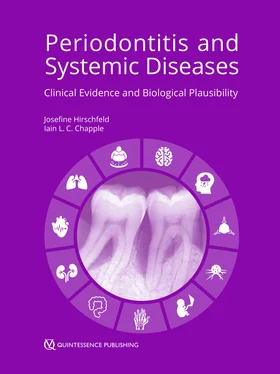
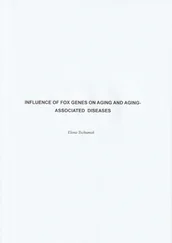
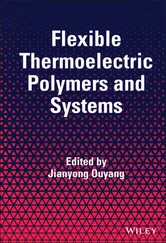
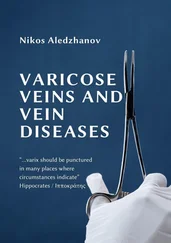





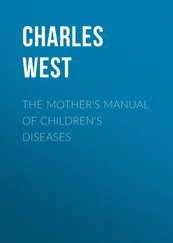

![John Bruce - The Lettsomian Lectures on Diseases and Disorders of the Heart and Arteries in Middle and Advanced Life [1900-1901]](/books/749387/john-bruce-the-lettsomian-lectures-on-diseases-and-disorders-of-the-heart-and-arteries-in-middle-and-advanced-life-1900-1901-thumb.webp)
